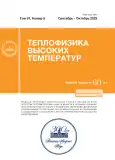Thermal State of a Region with a Thermally Insulated Moving Boundary
- 作者: Kartashov E.M.1
-
隶属关系:
- MIREA–Russian Technological University (Lomonosov Moscow Institute of Fine Chemical Technology)
- 期: 卷 61, 编号 5 (2023)
- 页面: 714-722
- 栏目: Heat and Mass Transfer and Physical Gasdynamics
- URL: https://journals.rcsi.science/0040-3644/article/view/252364
- DOI: https://doi.org/10.31857/S004036442305006X
- ID: 252364
如何引用文章
全文:
详细
Mathematical model representations of the temperature effect in regions with a thermally insulated moving boundary are developed. The boundary conditions for thermal insulation of a moving boundary are formulated both for locally equilibrium heat transfer processes within the classical Fourier phenomenology and for more complex locally nonequilibrium processes within the Maxwell–Cattaneo–Lykov–Vernott phenomenology, taking into account the finite speed of heat propagation. The applied problem of heat conductance and the theory of thermal shock for a region with a moving thermally insulated boundary, free from external and internal influences, is considered. An exact analytical solution of the formulated mathematical models for equations of the hyperbolic type is obtained. Methods and theorems of operational calculus and Riemann–Mellin contour integrals are used to calculate the originals of complex images with two branch points. A mathematical apparatus for the equivalence of functional structures for the originals of the obtained operational solutions is proposed. It is shown that the presence of a thermally insulated moving boundary leads to the appearance of a temperature gradient in the region and, consequently, to the appearance in the region of a temperature field and corresponding thermoelastic stresses of a wave nature. A numerical experiment is presented and the possibility of transition from one form of analytical solution of the temperature problem to another equivalent form is shown. The described effect manifests itself both for equations of the parabolic type based on classical Fourier phenomenology and for equations of hyperbolic type based on the generalized phenomenology of Maxwell–Cattaneo–Lykov–Vernott.
作者简介
E. Kartashov
MIREA–Russian Technological University (Lomonosov Moscow Institute of Fine Chemical Technology)
编辑信件的主要联系方式.
Email: professor.kartashov@gmail.com
119571, Moscow, Russia
参考
- Карташов Э.М. Тепловое разрушение полимерных волокон в теории временной зависимости прочности // Тонкие химические технологии. 2021. Т. 16. № 6. С. 526.
- Карташов Э.М., Соловьев И.А. Стохастический анализ эффекта возникновения градиента температуры при теплоизолированной движущейся границе // Изв. РАН. Сер. Энергетика. 2017. № 1. С. 1.
- Карташов Э.М., Кудинов В.А. Аналитические методы теории теплопроводности и ее приложений. М.: URSS, 2017. 1090 с.
- Vernott P. Les paradoxes de la theorie continue de l’ eguation de la chaleur // Comptess Rendus. 1958. V. 246(22). P. 3154.
- Лыков А.В. Теория теплопроводности. М.: Высшая школа, 1967. 600 с.
- Cattaneo C. Sur une forme de l’ eguation de la chaleur eliminant le paradoxe d’ une propagation instantance // Comptess Rendus.1958. V. 247(4). P. 431.
- Лыков А.В. Применение методов термодинамики необратимых процессов к исследованию тепло- и массообмена // ИФЖ. 1965. Т. 9. № 3. С. 287.
- Баумейстер К., Хамилл Т. Гиперболическое уравнение теплопроводности. Решение задачи о полубесконечном теле // Теплопередача. 1969. № 4. С. 112.
- Соболев С.Л. Локально-неравновесные модели процессов переноса // УФН. 1997. Т. 167(10). С. 1095.
- Жоу Д., Касас-Баскес Х., Лебон Дж. Расширенная необратимая термодинамика. М.–Ижевск: Институт комплексных исследований, 2006. 528 с.
- Кудинов В.А., Кудинов И.В. Получение и анализ точного аналитического решения гиперболического уравнения теплопроводности для плоской стенки // ТВТ. 2012. Т. 50. № 1. С. 118.
- Кудинов В.А., Кудинов И.В. Исследование теплопроводности с учетом конечной скорости распространения теплоты // ТВТ. 2013. Т. 51. № 2. С. 301.
- Кирсанов Ю.А. Моделирование теплофизических процессов. СПб.: Политехника, 2022. 230 с.
- Еремин А.В. Исследование быстрорелаксирующих температурных возбуждений, вызываемых сверхкороткими лазерными импульсами // Современная наука. Естественные и технические науки. 2019. № 8. С. 47.
- Еремин А.В. Об одном методе математического моделирования процесса переноса теплоты в твердых телах // Перспективы науки. 2019. Т. 7(118). С. 101.
- Еремин А.В. Методология моделирования тепломассопереноса, упругих колебаний и электромагнитных волн с учетом пространственно-временной нелокальности. Автореферат дис. … докт. техн. наук. Самара, 2021. 30 с.
- Жуков В.В. Исследование внутренних механизмов переноса тепла, массы, импульса с учетом релаксационных явлений. Автореферат дис. … канд. техн. наук. Самара, 2021. 18 с.
- Формалев В.Ф. Уравнения математической физики. М.: URSS, 2020. 648 с.
- Карташов Э.М. Аналитические решения гиперболических моделей переноса // ИФЖ. 2014. Т. 87. № 5. С. 1072.
- Карташов Э.М., Кудинов В.А. Аналитическая теория теплопроводности и прикладной термоупругости. М.: URSS, 2012. 650 с.
- Карташов Э.М. Развитие обобщенных модельных представлений теплового удара для локально-неравновесных процессов переноса теплоты // Российский технологический журнал. 2023. № 11(3). С. 70.











